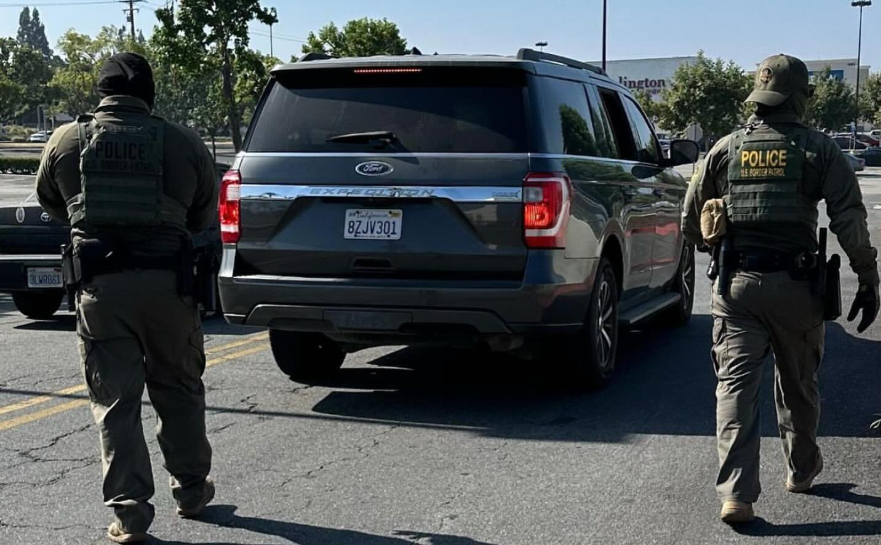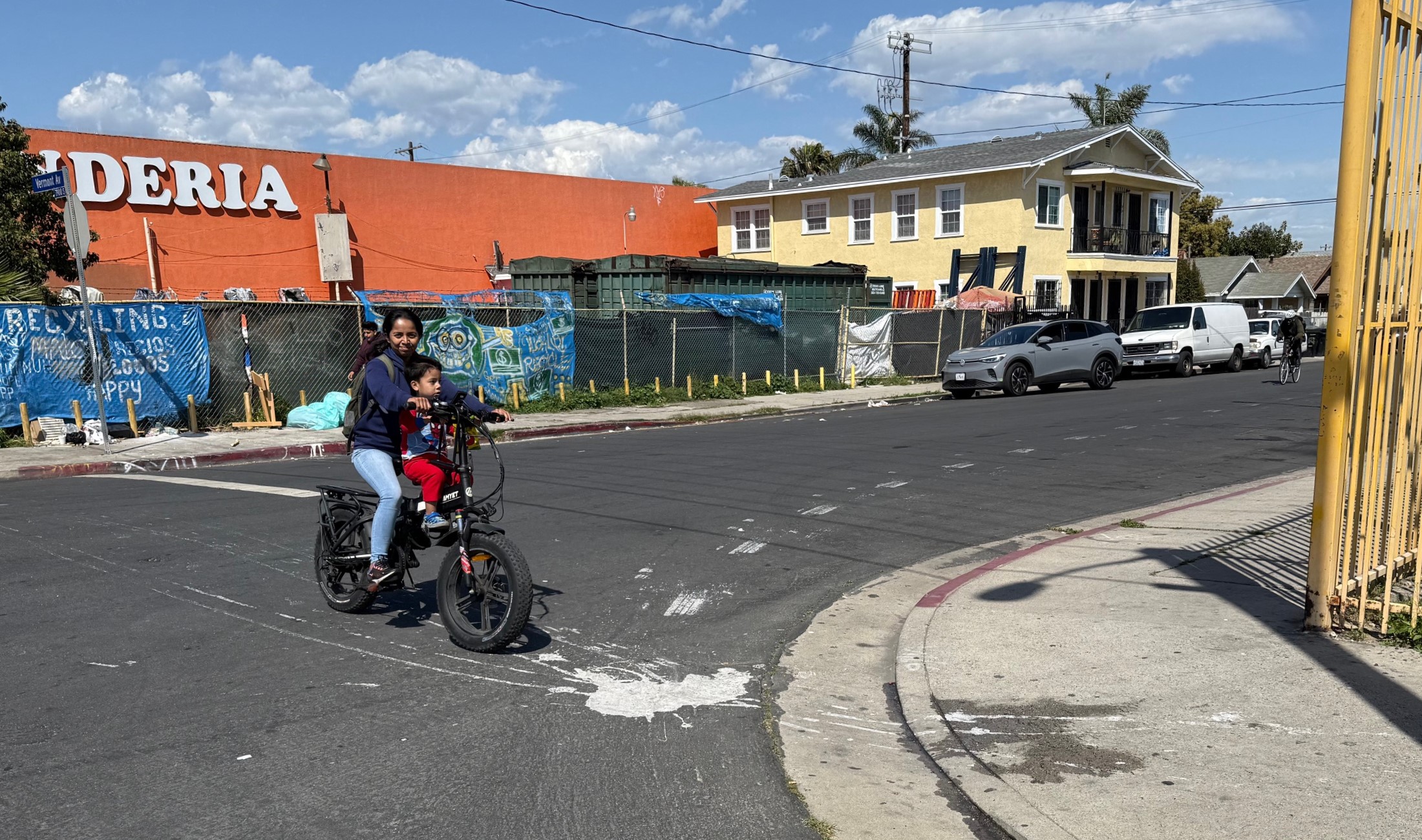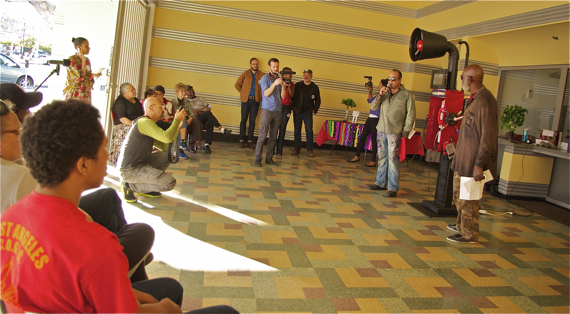
Gesturing towards the re-purposed pay phone prototype, KAOS Network founder Ben Caldwell said he looked at the Leimert Phone Company project as a way to exact "a handshake between 20th century objects and 21st century objects."
Just because we were living in an era of rapid change, he continued, there was no need to throw the babies out with the bathwater or cut all ties to what came before.
It was an apt metaphor for where Leimert Park finds itself at this moment.
The area has undergone significant changes in recent years, some of which have been hastened by the speculation (and, finally, confirmation) that the area would host a train station along the new Crenshaw Line.
While the station will be a welcome addition to the neighborhood, many fear that gentrification, rising rents, and developers will push out the very people and culture the station was intended to showcase. You can already find a number of empty storefronts around the plaza in buildings that were recently purchased by developers and important cultural and artistic hubs like The World Stage are struggling to scrape together funds and support so they can stay where they are.
All of which is what makes the Leimert Phone Company project -- a unique collaboration between USC, the KAOS Network, and artists from Leimert Park -- so timely.
When I first connected Caldwell with Professor François Bar of USC's Annenberg Innovation Lab at a get-to-know-you meeting at USC last year, it was in the hopes of setting up a collaborative spoken word bike- or walking-tour-cum-mapping project of Leimert Park. I knew that Caldwell, an artist and filmmaker with a love for history and a unique ability to bridge past and present, had long been interested in recording the stories of the area. Meanwhile, Bar and his team had only recently concluded a community-based assets-mapping project in Watts. While the final output -- a colorful map -- hadn't necessarily led people to see their neighborhood in a new light, as the team had hoped, I found the community-specific map to be an incredibly useful tool for starting conversations about people's longer-term aspirations for their communities or inviting them to participate in community bike rides.
I figured that, together, Caldwell and Bar might be able to create something along the lines of a digital map populated with artists' interpretations or recollections of particular locations and tours that could be built around site-based performances. Such a project, I hoped, would help capture the essential culture and history of the place in the voices of those who lived it, while giving outsiders the context they needed to explore and appreciate the neighborhood.
Clearly, I wasn't thinking big enough.
Within just a few months of that meeting, I would hear that they were collaborating on a design studio that would be centered around hacking into and re-purposing public pay phones.
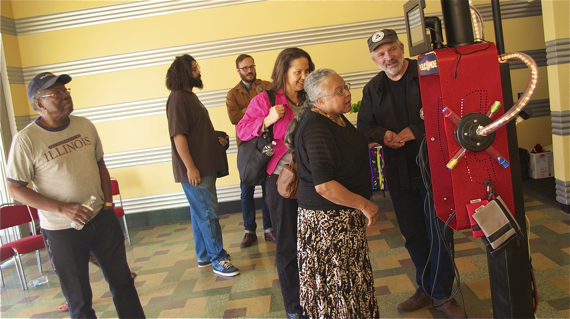
The inspiration had come, Caldwell said, from a story he had heard about how public phones had been re-purposed into ATMs. He had looked at the lonely phone sitting outside his door at KAOS and asked himself that age-old question, "What would artists do?"
How could they populate obsolete urban furniture with storytelling, music, art, images, video, or information about local businesses in a way that would both enhance users' relationship to the public space and benefit the community?
During the 5-week course held this past spring, USC students and Leimert Park artists and neighbors worked to answer those questions. Working in teams, they envisioned ways the phone booth could record and play stories from residents, offer up selections from local musicians, preview art for sale in the area, or serve as a wi-fi hotspot that would make local businesses more attractive.
They presented their final concepts for how the phones could be transformed into community assets at a pitch session this past April. Then, in June, they took their show on the road, heading to the Allied Media Conference in Detroit to give a presentation entitled, "Phone Booths Against Gentrification."
And, while you might be right to wonder about the extent to which a funkified phone booth can stave off gentrification, the unveiling of the prototype this past weekend hinted at how its mere existence could spark the imagination of community members.
When artist Janet Dandridge kicked off the launch by pressing a button on the phone and playing a story from a woman who spoke frankly of being concerned about the changes Leimert Park was experiencing, I saw people sit up a little straighter in their chairs.
They clearly hadn't expected that the very first "story" showcased would be one questioning gentrification.
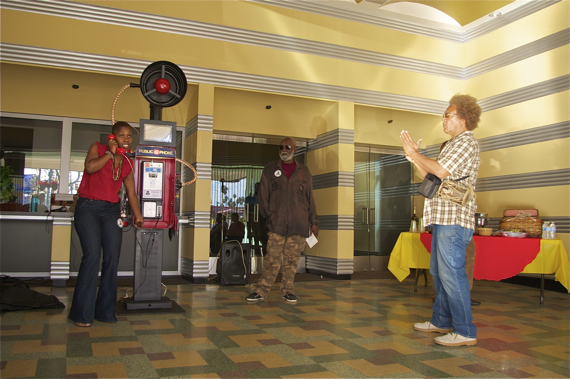
Matt Gibson, photographer, stage manager for The World Stage, and drum circle regular, who had happened to stop by the Vision Theater just before the launch began, took up the microphone and declared the art piece was "hitting me like a ton of bricks."
The idea that the phone could give community members the opportunity to tell their own stories in their own way, he said, was so essential in a world in which "media only lets certain stories be told."
"We need to tell our own stories..." he reiterated, "...so they don't become wives' tales."
After the formal presentation concluded, I spoke with Gibson at length about the project, the possibility of recording stories at the World Stage's writers' workshop, and balancing the need to collaborate with organizations from outside the area to survive with that of remaining true to what the area is and represents. Artists like those at the World Stage have operated outside the mainstream for so long and, in the case of the writers that found a home there after the 1992 uprisings, have both been so critical of it and survived in spite of it, that finding ways to build partnerships outside the community is a whole new frontier. And not one they necessarily relish needing to explore.
But Leimert is changing. Quickly. Without collaborations and injections of new resources into the area, it is entirely possible that some of the cultural mainstays will not survive the transition.
That doesn't mean that a cool, post-apocalyptic-looking phone that plays community stories is going to single-handedly save the day, of course. What it represents, however -- a potential model for unique, innovative, and mutually-beneficial collaborations in which the community is understood as a resource -- just might be the key to residents being able to have a say in the transformation of their neighborhood. And that is exciting.
More on the Leimert Phone Company can be found here. More about the technology (the Raspberry Pi) used to power the phone and a look at its guts can be found here.
